Abstract
The age and sex specific incidence rates, the case fatality rates, and the functional outcome of patients with primary intracerebral haemorrhage occurring in a population of 116,000 during a period of four years four months are presented. A total of 158 patients were identified, the diagnosis was confirmed in 78% by CT, and in 22% by necropsy. The crude annual incidence rate was 31/100,000 population, the age specific rates increased from two to 222/100,000 from the age of 30-39 to over 80 years. Men had higher incidence rates between the ages of 40 and 79 years. The short term case fatality rate was high, 27% of patients dying during the first day after onset of symptoms, and 50% were dead at 30 days. After the first month the probability of survival did not differ from an age- and sex-matched average population. Large haematoma volume had an adverse effect on the short term, old age (greater than 70 years) on the long term survival. Ventricular extension, especially when combined with hydrocephalus was a bad omen for short term survival. Infratentorial and large basal ganglionic haematomas, and primary intraventricular haemorrhage carried a worse prognosis than haematomas of other locations. At the end of a median 32 month follow up 55 (35%) of the patients were alive, 51% of these were independent in activities of daily living, 45% were dependent on outside help, and 4% needed constant nursing care. Old age (greater than 70 years), but not the haematoma volume or location, was associated with a poor functional recovery.
Full text
PDF
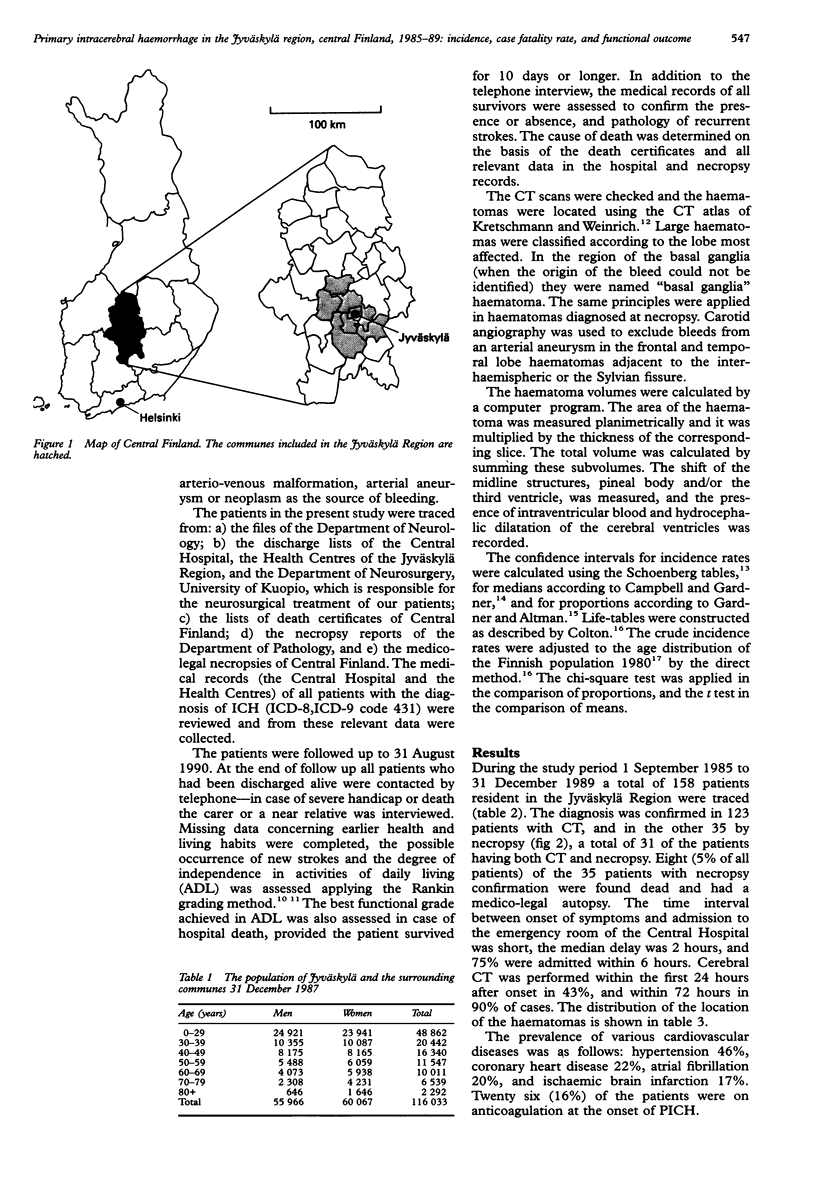
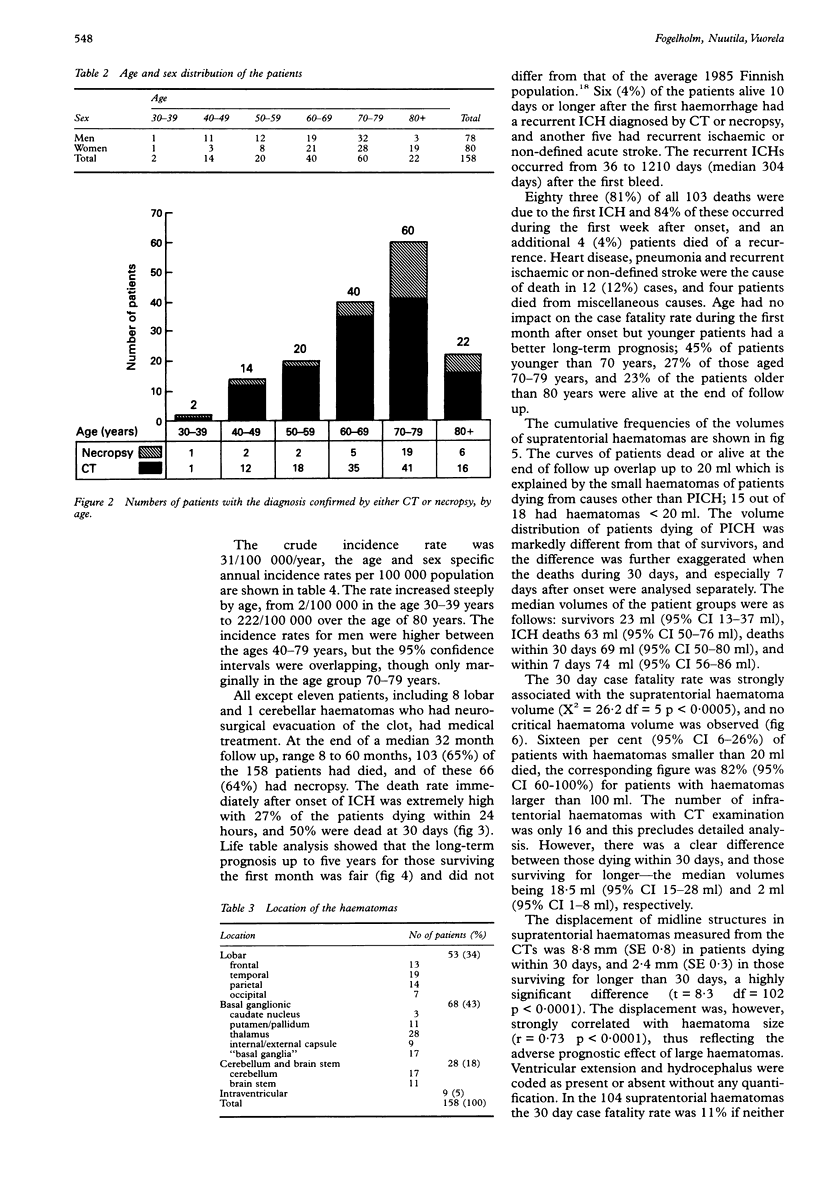
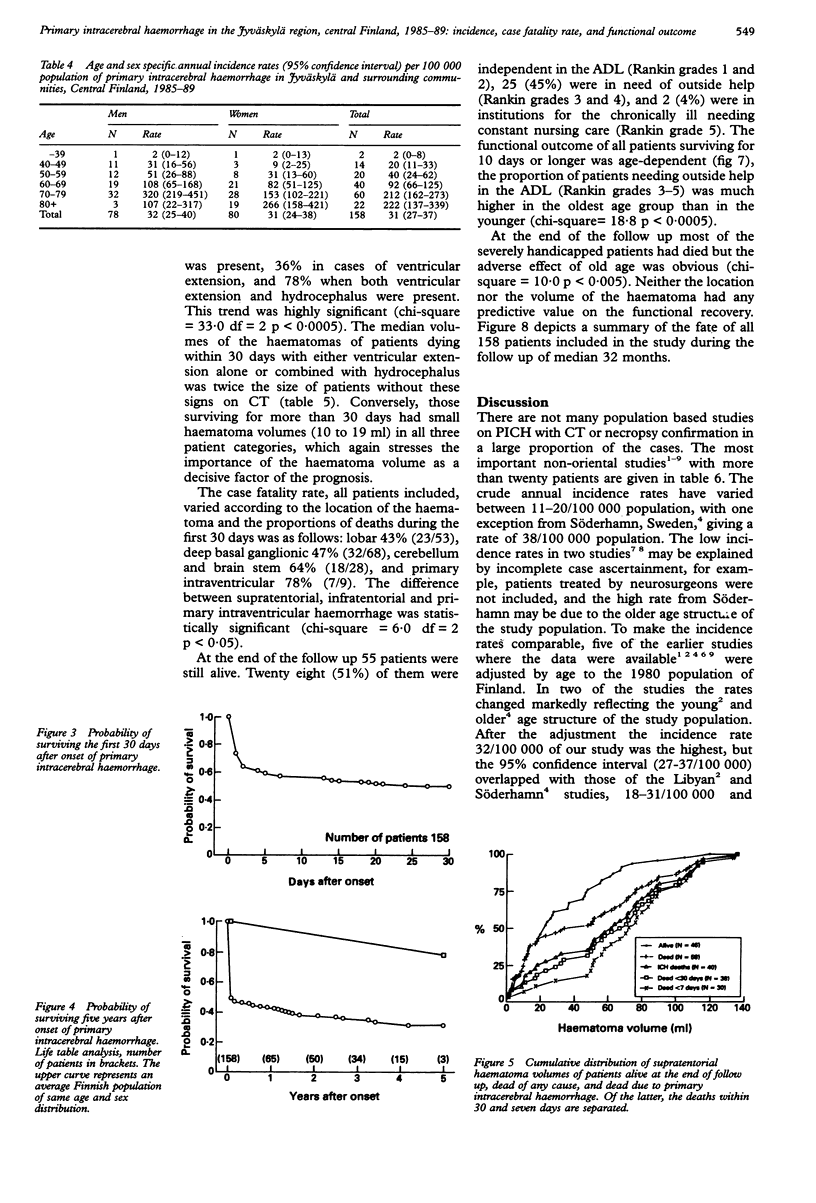

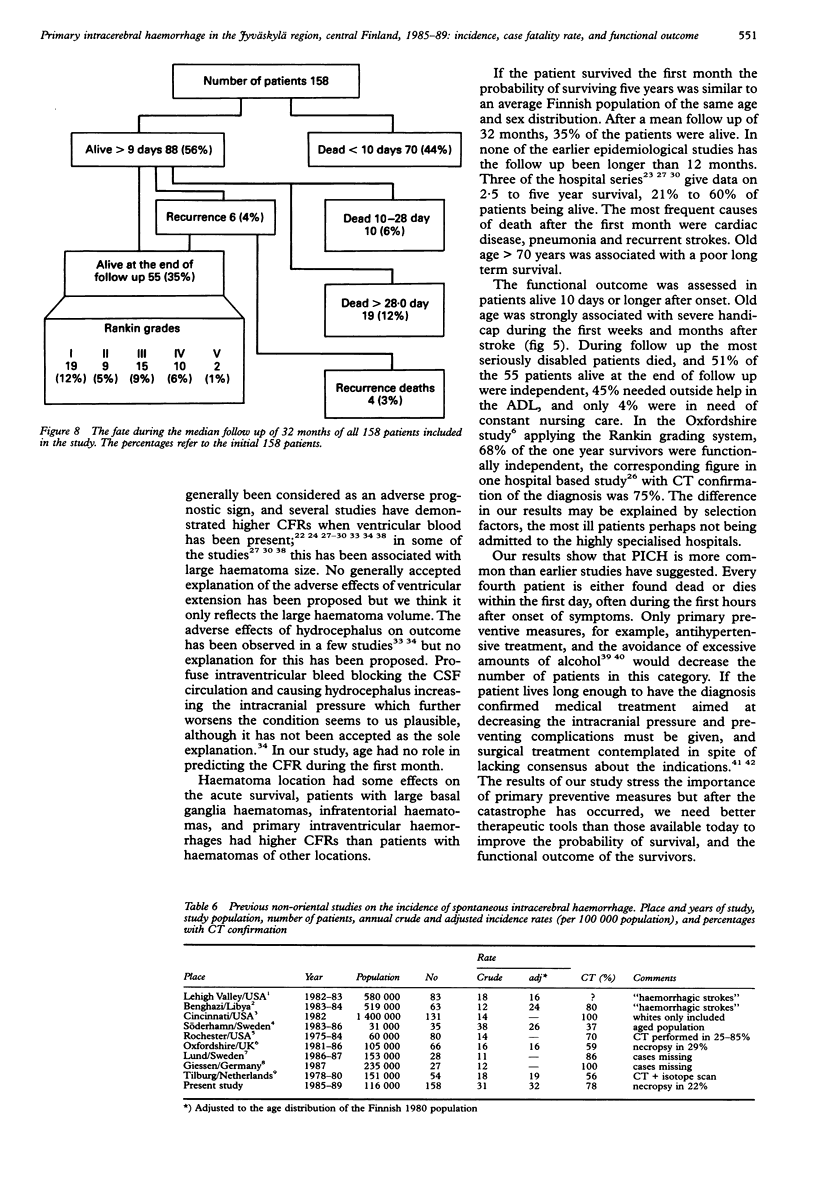
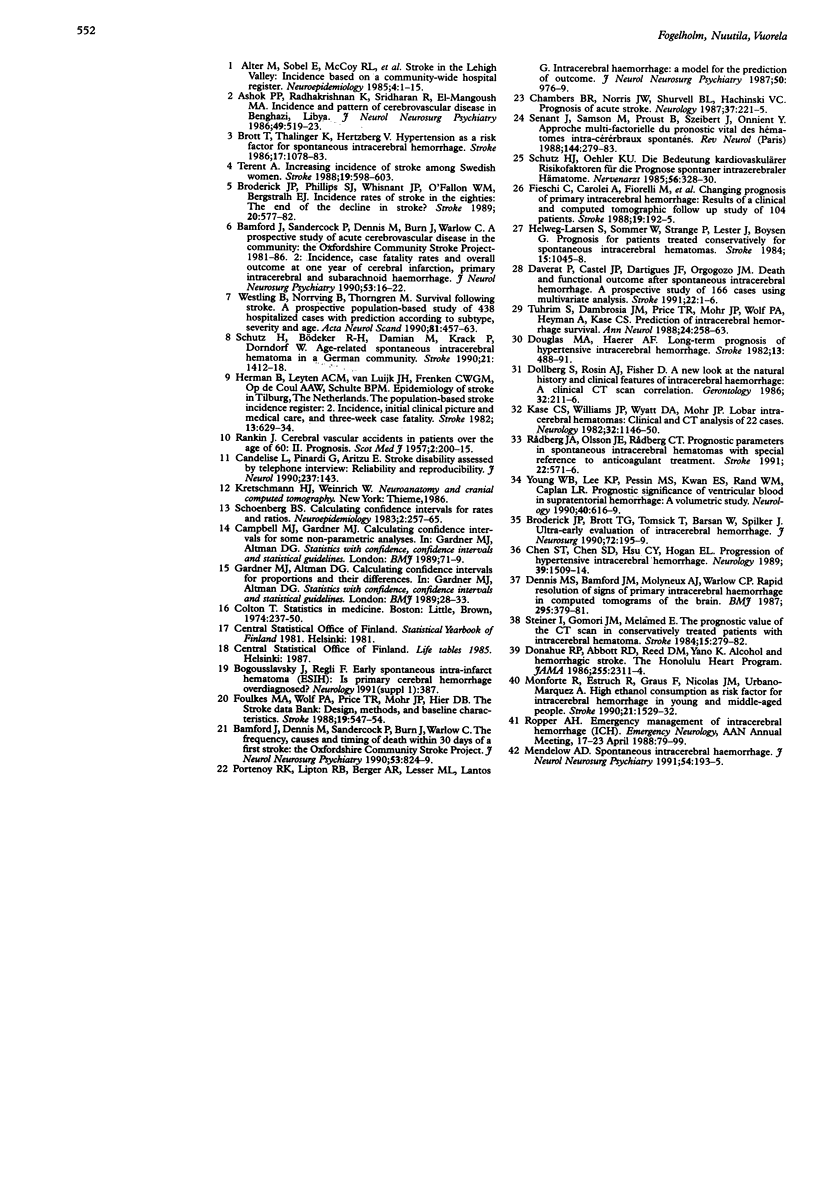
Selected References
These references are in PubMed. This may not be the complete list of references from this article.
- Alter M., Sobel E., McCoy R. L., Francis M. E., Shofer F., Levitt L. P., Meehan E. F. Stroke in the Lehigh Valley: incidence based on a community-wide hospital register. Neuroepidemiology. 1985;4(1):1–15. doi: 10.1159/000110209. [DOI] [PubMed] [Google Scholar]
- Ashok P. P., Radhakrishnan K., Sridharan R., el-Mangoush M. A. Incidence and pattern of cerebrovascular diseases in Benghazi, Libya. J Neurol Neurosurg Psychiatry. 1986 May;49(5):519–523. doi: 10.1136/jnnp.49.5.519. [DOI] [PMC free article] [PubMed] [Google Scholar]
- Bamford J., Dennis M., Sandercock P., Burn J., Warlow C. The frequency, causes and timing of death within 30 days of a first stroke: the Oxfordshire Community Stroke Project. J Neurol Neurosurg Psychiatry. 1990 Oct;53(10):824–829. doi: 10.1136/jnnp.53.10.824. [DOI] [PMC free article] [PubMed] [Google Scholar]
- Bamford J., Sandercock P., Dennis M., Burn J., Warlow C. A prospective study of acute cerebrovascular disease in the community: the Oxfordshire Community Stroke Project--1981-86. 2. Incidence, case fatality rates and overall outcome at one year of cerebral infarction, primary intracerebral and subarachnoid haemorrhage. J Neurol Neurosurg Psychiatry. 1990 Jan;53(1):16–22. doi: 10.1136/jnnp.53.1.16. [DOI] [PMC free article] [PubMed] [Google Scholar]
- Broderick J. P., Brott T. G., Tomsick T., Barsan W., Spilker J. Ultra-early evaluation of intracerebral hemorrhage. J Neurosurg. 1990 Feb;72(2):195–199. doi: 10.3171/jns.1990.72.2.0195. [DOI] [PubMed] [Google Scholar]
- Broderick J. P., Phillips S. J., Whisnant J. P., O'Fallon W. M., Bergstralh E. J. Incidence rates of stroke in the eighties: the end of the decline in stroke? Stroke. 1989 May;20(5):577–582. doi: 10.1161/01.str.20.5.577. [DOI] [PubMed] [Google Scholar]
- Brott T., Thalinger K., Hertzberg V. Hypertension as a risk factor for spontaneous intracerebral hemorrhage. Stroke. 1986 Nov-Dec;17(6):1078–1083. doi: 10.1161/01.str.17.6.1078. [DOI] [PubMed] [Google Scholar]
- Chambers B. R., Norris J. W., Shurvell B. L., Hachinski V. C. Prognosis of acute stroke. Neurology. 1987 Feb;37(2):221–225. doi: 10.1212/wnl.37.2.221. [DOI] [PubMed] [Google Scholar]
- Chen S. T., Chen S. D., Hsu C. Y., Hogan E. L. Progression of hypertensive intracerebral hemorrhage. Neurology. 1989 Nov;39(11):1509–1514. doi: 10.1212/wnl.39.11.1509. [DOI] [PubMed] [Google Scholar]
- Daverat P., Castel J. P., Dartigues J. F., Orgogozo J. M. Death and functional outcome after spontaneous intracerebral hemorrhage. A prospective study of 166 cases using multivariate analysis. Stroke. 1991 Jan;22(1):1–6. doi: 10.1161/01.str.22.1.1. [DOI] [PubMed] [Google Scholar]
- Dennis M. S., Bamford J. M., Molyneux A. J., Warlow C. P. Rapid resolution of signs of primary intracerebral haemorrhage in computed tomograms of the brain. Br Med J (Clin Res Ed) 1987 Aug 8;295(6594):379–381. doi: 10.1136/bmj.295.6594.379. [DOI] [PMC free article] [PubMed] [Google Scholar]
- Dollberg S., Rosin A. J., Fisher D. A new look at the natural history and clinical features of intracerebral haemorrhage: a clinical CT scan correlation. Gerontology. 1986;32(4):211–216. doi: 10.1159/000212792. [DOI] [PubMed] [Google Scholar]
- Donahue R. P., Abbott R. D., Reed D. M., Yano K. Alcohol and hemorrhagic stroke. The Honolulu Heart Program. JAMA. 1986 May 2;255(17):2311–2314. [PubMed] [Google Scholar]
- Douglas M. A., Haerer A. F. Long-term prognosis of hypertensive intracerebral hemorrhage. Stroke. 1982 Jul-Aug;13(4):488–491. doi: 10.1161/01.str.13.4.488. [DOI] [PubMed] [Google Scholar]
- Fieschi C., Carolei A., Fiorelli M., Argentino C., Bozzao L., Fazio C., Salvetti M., Bastianello S. Changing prognosis of primary intracerebral hemorrhage: results of a clinical and computed tomographic follow-up study of 104 patients. Stroke. 1988 Feb;19(2):192–195. doi: 10.1161/01.str.19.2.192. [DOI] [PubMed] [Google Scholar]
- Foulkes M. A., Wolf P. A., Price T. R., Mohr J. P., Hier D. B. The Stroke Data Bank: design, methods, and baseline characteristics. Stroke. 1988 May;19(5):547–554. doi: 10.1161/01.str.19.5.547. [DOI] [PubMed] [Google Scholar]
- Helweg-Larsen S., Sommer W., Strange P., Lester J., Boysen G. Prognosis for patients treated conservatively for spontaneous intracerebral hematomas. Stroke. 1984 Nov-Dec;15(6):1045–1048. doi: 10.1161/01.str.15.6.1045. [DOI] [PubMed] [Google Scholar]
- Herman B., Leyten A. C., van Luijk J. H., Frenken C. W., Op de Coul A. A., Schulte B. P. Epidemiology of stroke in Tilburg, the Netherlands. The population-based stroke incidence register: 2. Incidence, initial clinical picture and medical care, and three-week case fatality. Stroke. 1982 Sep-Oct;13(5):629–634. doi: 10.1161/01.str.13.5.629. [DOI] [PubMed] [Google Scholar]
- Kase C. S., Williams J. P., Wyatt D. A., Mohr J. P. Lobar intracerebral hematomas: clinical and CT analysis of 22 cases. Neurology. 1982 Oct;32(10):1146–1150. doi: 10.1212/wnl.32.10.1146. [DOI] [PubMed] [Google Scholar]
- Monforte R., Estruch R., Graus F., Nicolas J. M., Urbano-Marquez A. High ethanol consumption as risk factor for intracerebral hemorrhage in young and middle-aged people. Stroke. 1990 Nov;21(11):1529–1532. doi: 10.1161/01.str.21.11.1529. [DOI] [PubMed] [Google Scholar]
- Portenoy R. K., Lipton R. B., Berger A. R., Lesser M. L., Lantos G. Intracerebral haemorrhage: a model for the prediction of outcome. J Neurol Neurosurg Psychiatry. 1987 Aug;50(8):976–979. doi: 10.1136/jnnp.50.8.976. [DOI] [PMC free article] [PubMed] [Google Scholar]
- RANKIN J. Cerebral vascular accidents in patients over the age of 60. II. Prognosis. Scott Med J. 1957 May;2(5):200–215. doi: 10.1177/003693305700200504. [DOI] [PubMed] [Google Scholar]
- Rådberg J. A., Olsson J. E., Rådberg C. T. Prognostic parameters in spontaneous intracerebral hematomas with special reference to anticoagulant treatment. Stroke. 1991 May;22(5):571–576. doi: 10.1161/01.str.22.5.571. [DOI] [PubMed] [Google Scholar]
- Schütz H. J., Oehler K. U. Die Bedeutung kardiovaskulärer Risikofaktoren für die Prognose spontaner intrazerebraler Hämatome. Nervenarzt. 1985 Jun;56(6):328–330. [PubMed] [Google Scholar]
- Schütz H., Bödeker R. H., Damian M., Krack P., Dorndorf W. Age-related spontaneous intracerebral hematoma in a German community. Stroke. 1990 Oct;21(10):1412–1418. doi: 10.1161/01.str.21.10.1412. [DOI] [PubMed] [Google Scholar]
- Senant J., Samson M., Proust B., Szeibert J., Onnient Y. Approache multi-factorielle du pronostic vital des hématomes intra-cérébraux spontanés. Rev Neurol (Paris) 1988;144(4):279–283. [PubMed] [Google Scholar]
- Steiner I., Gomori J. M., Melamed E. The prognostic value of the CT scan in conservatively treated patients with intracerebral hematoma. Stroke. 1984 Mar-Apr;15(2):279–282. doi: 10.1161/01.str.15.2.279. [DOI] [PubMed] [Google Scholar]
- Terént A. Increasing incidence of stroke among Swedish women. Stroke. 1988 May;19(5):598–603. doi: 10.1161/01.str.19.5.598. [DOI] [PubMed] [Google Scholar]
- Tuhrim S., Dambrosia J. M., Price T. R., Mohr J. P., Wolf P. A., Heyman A., Kase C. S. Prediction of intracerebral hemorrhage survival. Ann Neurol. 1988 Aug;24(2):258–263. doi: 10.1002/ana.410240213. [DOI] [PubMed] [Google Scholar]
- Westling B., Norrving B., Thorngren M. Survival following stroke. A prospective population-based study of 438 hospitalized cases with prediction according to subtype, severity and age. Acta Neurol Scand. 1990 May;81(5):457–463. doi: 10.1111/j.1600-0404.1990.tb00995.x. [DOI] [PubMed] [Google Scholar]
- Young W. B., Lee K. P., Pessin M. S., Kwan E. S., Rand W. M., Caplan L. R. Prognostic significance of ventricular blood in supratentorial hemorrhage: a volumetric study. Neurology. 1990 Apr;40(4):616–619. doi: 10.1212/wnl.40.4.616. [DOI] [PubMed] [Google Scholar]


